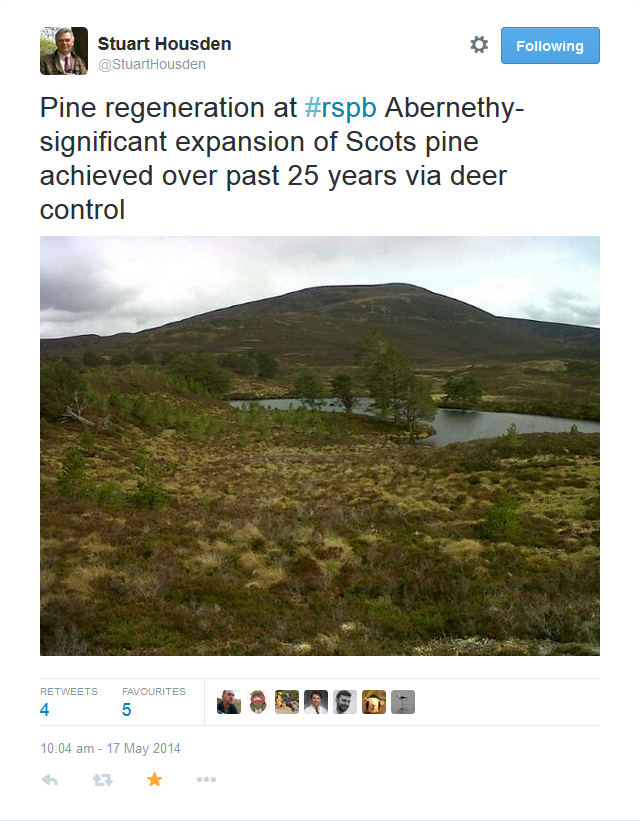To: Debbie Greene
Sent: 2 July 2015
Subject: RSPB Scotland’s planting plans for Abernethy
Debbie,
Thanks for your reply of 25 June 2015.
While the following may appear patronising or condescending – no nastiness of any kind is intended.
I am not alone in asserting that the decision to allow RSPB Scotland to plant trees within the de facto Caledonian Pinewood at Abernethy is a self-evident catastrophe for its authenticity and naturalness.
About 9,000 years ago, seedlings of the species we call Pinus sylvestris var. scotica began growing in the area that SNH designated Abernethy Forest SSSI. These seedlings grew to become part of (what, since ancient times, was known as) the Caledonian Forest. Various causes led to the fragmentation of that forest into primarily-deciduous and primarily-coniferous woodlands.
While Caledonian Pinewood may not be a statutory-designation, it must surely be a logical-designation, since it features in the title of the FC publication Caledonian Pinewood Inventory (1998) and since the Caledonian Forest is no-more, it makes sense to stop referring to it (except in a purely historical context) and – instead – refer to the remaining primarily-coniferous fragments as Caledonian Pinewoods.
There can be no doubt that the Caledonian Pinewood at Abernethy is authentic and natural and (to paraphrase the JNCC definition) it is relict Pinus sylvestris var. scotica, self-sown, naturally regenerating, genuinely native, local origin pinewood.
The existing trees of this pinewood are the latest links in an unbroken chain of natural evolution connecting them to the first seedlings to grow there 9,000 yeas ago. It is this Caledonianess that makes the pinewood scientifically valuable. It is this Caledonianess that makes Nature the only scientifically justifiable agent in the regeneration and expansion of the pinewood. It is neither the number of trees nor the extent of the pinewood that makes it scientifically valuable. Planting will increase the number of trees and extend the pinewood, but, by breaking the chain of natural evolution it will also diminish the authenticity and naturalness of it – it would become merely ‘Native’ rather than ‘Caledonian’ because ‘self-sown’ is an essential clause in its definition.
During their first decade at Abernethy, RSPB Scotland would have agreed with the foregoing. One need not be much of a researcher to find unequivocal, published statements by them referring to ‘purely natural regeneration’ and ‘no planting or fencing’. But sometime in the early 2000s they appear to have changed their mind – for whatever reason – they are prioritising increasing the number of trees and extent of the pinewood over authenticity and naturalness. Recently, as a direct result of RSPB Scotland’s own actions to reduce red deer numbers, both Stuart Housden and Jeremy Roberts have (rightly) boasted about how well the pinewood is regenerating while claiming full responsibility for 800 hectares of regeneration. Elsewhere, RSPB Scotland make contradictory ‘struggling to survive’ claims about the condition of the pinewood.
Looking on the SNH website – I note that ‘It is an offence for any person to intentionally or recklessly damage the protected natural features of an SSSI’ and on Sitelink – I note that for Abernethy Forest SSSI that the ‘Coniferous woodland’ is a ‘Notified feature’.
1. How can it be that the RSPB Scotland’s planting within the Caledonian Pinewood at Abernethy is not causing ‘intentional or reckless damage’ to this ‘notified feature’ when planting is contrary to the essential clauses defining it ?
2. If the scientific value of the Caledonian Pinewood at Abernethy is its Caledonianess and not the number of trees nor the extent of the pinewood – then how can planting ‘benefit the statutory natural heritage designations’ when planting is contrary to the essential clauses defining it ?
In your answers please provide references to Policy and Procedure documentation that will enable me to understand the steps in the process by which SNH arrived at the decision that planting ‘will benefit the statutory natural heritage designations’ of the Caledonian Pinewood at Abernethy.
For the avoidance of doubt – please avoid justifying or defending the SNH decision. I merely want to know how and why SNH came to approve the planting-plan rather than reject it because it involves planting. I would not have guessed that RSPB Scotland could ever be permitted to plant within the Caledonian Pinewood at Abernethy.
It appears self-evident that the approval of the planting-plan was an error, that was either (a) an error of judgement / interpretation etc. within SNH, or (b) an error of policy / process – that given the process SNH is required to follow, that SNH could only have given approval, or (c) subversion – that (in spite of knowing and understanding the foregoing) that the SNH policy / process (that would have led to the rejection of the planting-plan) was subverted with intent, to enable RSPB Scotland to do what they want within the Caledonian Pinewood at Abernethy. Either way – the decision process should be repeatable – you should be able to show me how (given knowledge of SNH policy / procedure) I would reach the same conclusion.
I have not seen a letter by you to Adam Watson dated 14 July 2014 and would very much appreciate seeing it, but if you mean the one dated 17 July 2014 – I have seen that. I referred to it and quoted from it in my first email to you.
Joe Dorward
Bracknell








